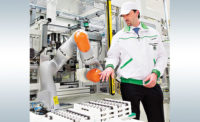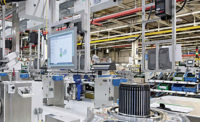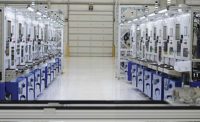Saving a penny per part or a millisecond of cycle time might not matter to some manufacturers. But machine builder Eclipse Automation knows that even small gains can offer huge competitive advantages for its customers. Greater flexibility and uptime through predictive maintenance are also crucial.
To stay on the leading edge, Eclipse engineers constantly research new technologies to help their customers succeed. “We test all kinds of new technologies, including artificial intelligence, remote training, virtual reality for maintenance systems, and any components that add precision and flexibility,” says Jeff Werner, general manager for Eclipse, based in Cambridge, ON. “One technology that has proven particularly important to us is linear transport systems.”
Recently, Eclipse updated a successful system that uses the eXtended Transport System (XTS) from Beckhoff Automation to assemble automotive transmission pumps. The base system features four separate cells with more than 50 stations for pressing, soldering, screwdriving, flatness checks with LVDTs, dispensing, plasma treatment, leak testing, inspection and other processes. Many stations require precise synchronization with robotics. The updated system can now assemble two different pumps at the same time.
The XTS plays a crucial role. The adaptive mechatronics allow the customer, a Tier 1 automotive supplier, to assemble parts with different pitches without time-consuming changeovers or separate tooling at each station.
The project’s challenges were unique, but par for the course for the Eclipse engineering team. Eclipse was founded in 2001 to serve the custom automation market and has grown exponentially. The Canadian company quickly gained respect for taking on challenging applications with difficult time frames. In addition to its state-of-the-art manufacturing campus in Cambridge, Eclipse has offices in the U.S., Germany, Switzerland, Hungary and Malaysia. Besides the automotive sector, the company serves a variety of other industries, including life sciences, consumer products and even nuclear energy. “Eclipse has developed a solid reputation with many Fortune 50 companies around the world for delivering flexible systems with high quality, reliability and traceability,” Werner says.
.
Initial Machine Design Proven in the Field
The new transmission pump assembly system is the second version Eclipse built. The customer had requested the first system to replace several legacy machines that manufactured just one product type. At that time, the machines could not achieve the throughput and quality standards necessary for this high-volume product, according to Matthew Kelly, software design supervisor at Eclipse.
“The previous machines used rotary dial tables and similar components. Each station only did one process, and if any station went down, it impacted the entire line,” says Kelly.
While increasing functional capabilities, the custom solution from Eclipse needed to minimize footprint. “Floor space is always at a premium, but this customer’s assembly and process equipment are extremely consolidated. When we proposed the system, they said, ‘We like the concept, but make it 25 percent smaller.’ We didn’t know if that was possible,” Werner says.
To solve these challenges, Eclipse worked closely with the local Beckhoff Canada team, including regional sales manager Dean Herron and applications specialist Andy Burleigh.
“XTS, along with the EtherCAT industrial Ethernet system and PC-based automation from Beckhoff, allowed Eclipse to concentrate an incredible number of processes in a small area and accomplish the dynamic motion control necessary to create the machine,” Burleigh says.
Combining the benefits of rotary and linear motion, XTS uses electromagnetic forces to propel movers along a track at high speeds with accelerations up to 100 meters per second squared. Unlike fixtures secured to rotary dial tables, XTS movers with robust encoder flags operate individually or in groups. Eliminating the dial and other mechanical components saves costs and space. Because each mover appears as an individual motion axis, it offers better traceability for each pump, at each step in the process. The mechatronic XTS has built-in EtherCAT communication and does not require any separate I/O hardware for system communication.
In the first three machine cells, operators place the pumps on pallets attached to XTS movers. The XTS systems are 12 meters long with 18 movers in the first cell, 6 meters with 12 movers in the second, and 10 meters with 18 movers in the third. The pallets’ carefully calculated pitch enables micron-level positioning. When all assembly processes are complete, the operator moves the pump to the next cell. At the third cell, a small conveyor moves the pump to the fourth cell, where a robot lifts the completed pump in front of two GigE cameras for a final vision inspection. It then places the pump on a conveyor for outfeed.
“XTS transitions products from station to station very quickly and accurately, and if there’s an issue with a part at any point in the process, we can bypass other stations and simply remove it,” Kelly explains. “We grouped multiple processes into a single station, which helped us further decrease footprint. With all the processes and tooling, it was the most condensed automation system I’ve ever seen.”
Next-Generation Challenge Appears
With the Eclipse team’s innovative design and implementation, the first assembly machine exceeded expectations and is still in use today. In December 2019, however, the automotive supplier requested a second machine with a new challenge: It would need to make a second pump on the same system. The pumps are different sizes and for different vehicle makes. This posed a challenge for the previously designed pallets, not to mention that some assembly steps happen in different orders for the two pumps. To maintain throughput, the system couldn’t afford the downtime to purge all of one pump type and then perform a lengthy changeover.
Working with the local Beckhoff team, Eclipse created a new concept relying on the fast cycle times of EtherCAT and the flexibility of XTS. “The system allows operators to quickly release and replace the pallet with a second type. This new pallet indexes forward and its specific position is measured to determine an offset. We apply those offsets to each individual pallet and make sure that components and parts line up exactly for the processes. So the operator can easily load part type A, wait one cycle, and then load part type B with negligible downtime,” Werner says. “Frankly, this design request seemed terrifying when we first concepted it, because of the high accuracy requirements. When we presented the bold idea of suddenly taking a pallet off and putting on a different one, there was silence in the room.”
In addition to the three XTS systems, the assembly line relies on other EtherCAT and PC-based automation technologies from Beckhoff. Each of the first three cells features a C6930 control cabinet industrial PC (IPC) to control the cell’s XTS track and peripheral devices. The IPCs enable TwinSAFE for functional safety across the entire line and communicate via EtherNet/IP to a secondary machine controller that controls other portions of the line. However, EtherCAT provided the system’s main communication and I/O.
“EtherCAT, as the world’s fastest fieldbus, delivers extremely short scan times, high bandwidth for data acquisition and free choice of topology with up to 65,535 nodes on a single network,” Herron says. “Real-time synchronization with robotics and servo components also allowed the engineers to perform interpolated motion for different dispense processes—in particular, applying adhesive in intricate patterns.”
To make this advanced functionality possible, TwinCAT 3 automation software was critical. The universal engineering and run-time platform from Beckhoff allowed Eclipse engineers to program G code that enables the XTS and Beckhoff AM8000 servomotors to perform coordinated motion for high precision dispensing. In addition, Eclipse took advantage of the capability to program with the object-oriented extensions of IEC 61131-3, predefined and custom function blocks, and computer science standards found in Microsoft Visual Studio.
“We can use ladder functionality if needed, but most of our programming is text-based,” Kelly explains. “For pallet control, pallet offset tables and similar requirements, Beckhoff offers many advantages compared to other options, and we save a significant amount of engineering time.”
Fast Product Changeovers
With the innovative design by Eclipse, the updated transmission pump assembly system met the specified cycle time of 20.2 seconds per part with micron-level accuracy. Since commissioning finished in early 2021, the system has produced roughly 1,000 parts per shift, running part A and part B in separate batches. The easy release and attachment of pallets, along with the instant automatic indexing of XTS, almost eliminated changeover times, pushing them down from more than an hour to just one minute.
“The customer was absolutely overwhelmed by the ability to perform that changeover considering the system’s extreme compactness and complexity of process,” Werner says. “It was a marvel of both controls and mechanical engineering to ensure easy release of these pallets without removing a single bolt.”
Pallets simply move to a storage buffer, and if one is damaged, the operator can easily replace it.
Because the XTS movers are not linked as in traditional designs, they can freely move the pallets around the track to specific process steps as needed, even if the order of the steps is different between the two pumps. Also, the mechatronic transport system helped Eclipse meet the customer’s footprint requirements. “Again, the flexibility of XTS made most of that possible,” Kelly adds. “Beckhoff offers an excellent linear transport system in terms of positional repeatability, accuracy for the stop positions of the pallets and speed—even when changing product pitch on the fly.”
Leveraging application experience with advanced linear transport technologies like XTS is just one way that Eclipse has kept innovation in its DNA. The company has tackled unprecedented high-speed and micro-assembly applications, including several COVID-19 test kit applications that also use XTS and PC-based control.
Werner sees this as important for providing highly efficient, cost-saving solutions to customers as well as attracting new engineering talent to work at Eclipse. “Most students are not learning traditional PLC programming. Instead, they leave university with a far better understanding of PC-based control systems than ever before, and that grows every year,” he says. “Fortunately, Beckhoff has proven to be a reliable partner for this as well as all areas of automation technology. When we have challenging applications, we’ll be ready to provide highly competitive solutions together.”
For more information on linear transport systems, control systems and other automation components, call Beckhoff at 952-890-0000 or visit www.beckhoff.com.
For more information on automated assembly systems, call Eclipse at 519-620-1906 or visit www.eclipseautomation.com.







